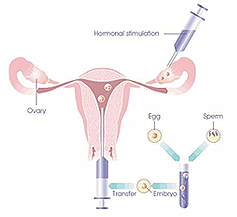Any medical technique that attempts to obtain a pregnancy by means other than intercourse is defined as ART.
TAMC is equipped with the skilled professionals who provide you with the full range of ART services to aid your infertility treatment to help you bear a child.
There are a number of different assisted conception treatments that may be available to you depending on the reasons you're having trouble. All of them aim to increase your chance of pregnancy by enhancing what happens in nature, through increasing the number of sperm that get to where the egg is, and/or increasing the number of eggs available for fertilization.

The chance of pregnancy with any assisted conception technique will depend on:
- Woman's age
- Reason/s why pregnancy hasn't happened naturally
- Expertise and technology of the clinic
- Strength & quality of the embryos that a couple produce
For couples experiencing infertility due to an extremely low (or zero) sperm count, no ovulation or completely blocked fallopian tubes - assisted conception will be the only way that pregnancy is possible. Couples with subfertility have a chance of becoming pregnant naturally, but that chance is reduced by factors such as a low sperm count, irregular ovulation, endometriosis, scarring of the fallopian tubes, fibroids or the increasing age of the woman. In about 1 in 5 couples, no apparent explanation for subfertility can be found. For any of these subfertile couples, assisted conception can speed up the process of becoming pregnant.
- Assisted insemination (also known as intrauterine insemination, or IUI)
- Ovulation induction
- In vitro fertilisation (IVF) and variations of IVF
All assisted conception techniques involve the monitoring of cycles to time procedures precisely. Developing follicles secrete increasing amounts of estrogen, particularly estradiol (E2). Blood tests that measure the level of E2 will detect a growing follicle.
Vaginal ultrasound examinations enable us to further monitor the ovarian response by counting and measuring the growing follicles as the E2 level rises. Once follicles reach 18-20 mm in diameter, they are big enough to produce a mature egg.
At Sydney IVF, we try not to interfere with your day-to-day life. Blood tests and ultrasounds for cycle monitoring are done early in the morning, enabling you to get on with the rest of your day. We will give you your results by phone later in the afternoon.